The purchase of a handmade grandfather clock is, for most people, a once in a lifetime event. So it is vital that this endeavor is carefully thought out and researched to make sure the end result is satisfactory.
In this buying guide, we help you think about the important questions that you should consider before making your purchase. We will also make you aware of the available options and features of a custom grandfather clock.
Table of Contents
Considerations Before Purchasing a Grandfather Clock

Why am I buying a clock? What is the occasion?
Grandfather clocks are purchased for many occasions, including:
- Sentimental reasons. Some shoppers remember having a grandfather clock in their home or in the grandparents home while growing up. Hearing the ticking clock and the sound of the chimes brings back memories of days gone by.
- A memorial for someone special. A grandfather clock can be purchased in honor of a loved one who has passed away or to celebrate an important milestone, like an anniversary or the birth of a child.
- A gift in celebration of an important relationship. This might include a relationship with a child, parent, or significant other.
- Lovers of fine furniture. Some shoppers simply appreciate the charm and elegance that a grandfather clock adds to the home.
Whatever the reason for purchasing a grandfather clock, it is best to consider all of the details and possibilities in order to avoid purchasing a clock that does not completely satisfy the desires in each situation.
Should I buy a custom clock, or a clock that’s ready to ship immediately?
The answer to this largely depends on whether or not you can find what you want and how quickly you want to have the clock delivered.
By far the most common brand of clock sold in the USA is Howard Miller, followed by Ridgeway. The main selling features of these clocks when compared to custom clocks is that they are ready to ship immediately after ordering and they generally carry a lower price tag than a custom clock that’s made in the USA.
The main reason that these clocks can be sold for a lower price is because production is outsourced to countries with cheap labor like China. With the low cost of labor, the clocks can be produced in large quantities for a lower price.
Another reason for the lower price tag is that some models are built using cheaper materials like particle board.
One downside of purchasing a ready-to-ship clock is that it generally cannot be customized to meet the customer’s needs. It is sold as-is with the colors and design specifics already chosen. For many clock buyers, this is not a problem. But if you prefer to have a voice in even the finer details of your clock design, and if you don’t mind waiting longer for your order to be delivered, you should go with a custom clock.
Am I willing to wait for a custom clock?
A custom grandfather clock typically requires anywhere from 8-20 weeks to be built and delivered. However, this is usually not a problem as those who know what they want in a clock are usually willing to wait for it. Compared to a lifetime of enjoying the clock, waiting a few more months to receive it is usually not a problem.
Now that you’ve answered some basic questions, you’re ready to learn more about grandfather clocks so that you can make a well informed decision.
Understanding Common Grandfather Clock Lingo
The photo below displays the names and location of some of the common parts of a grandfather clock.
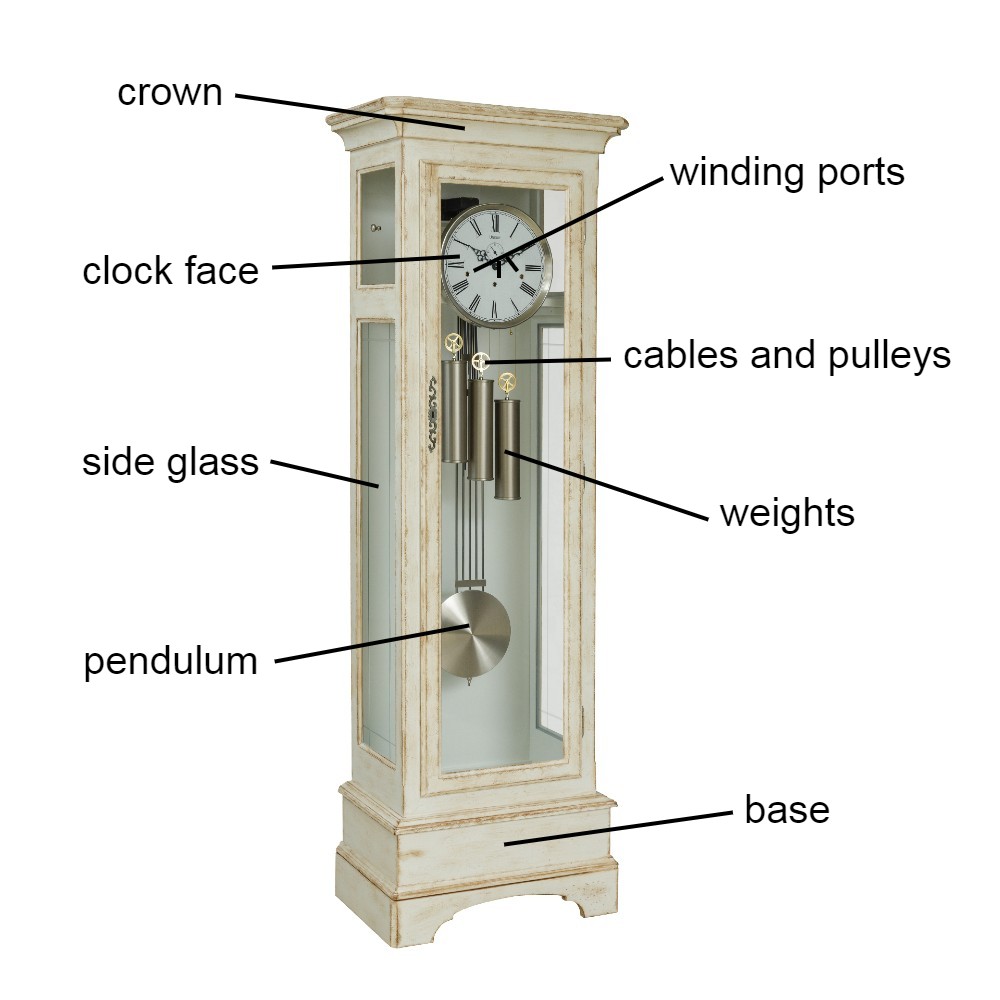
What Is a Grandfather Clock “Movement”?
The movement in a grandfather clock is the apparatus that controls the time keeping and the chiming of the clock. It is what makes the clock “tick”.
A typical movement includes the pendulum (the part that swings back and forth), the weights (the part that powers the clock), and the face and hands (the part that tells the time), the chime hammers and rods (the part that makes the chime sound), as well as the intricate inner workings (behind the clock face) that make all of these components work together in perfect harmony.
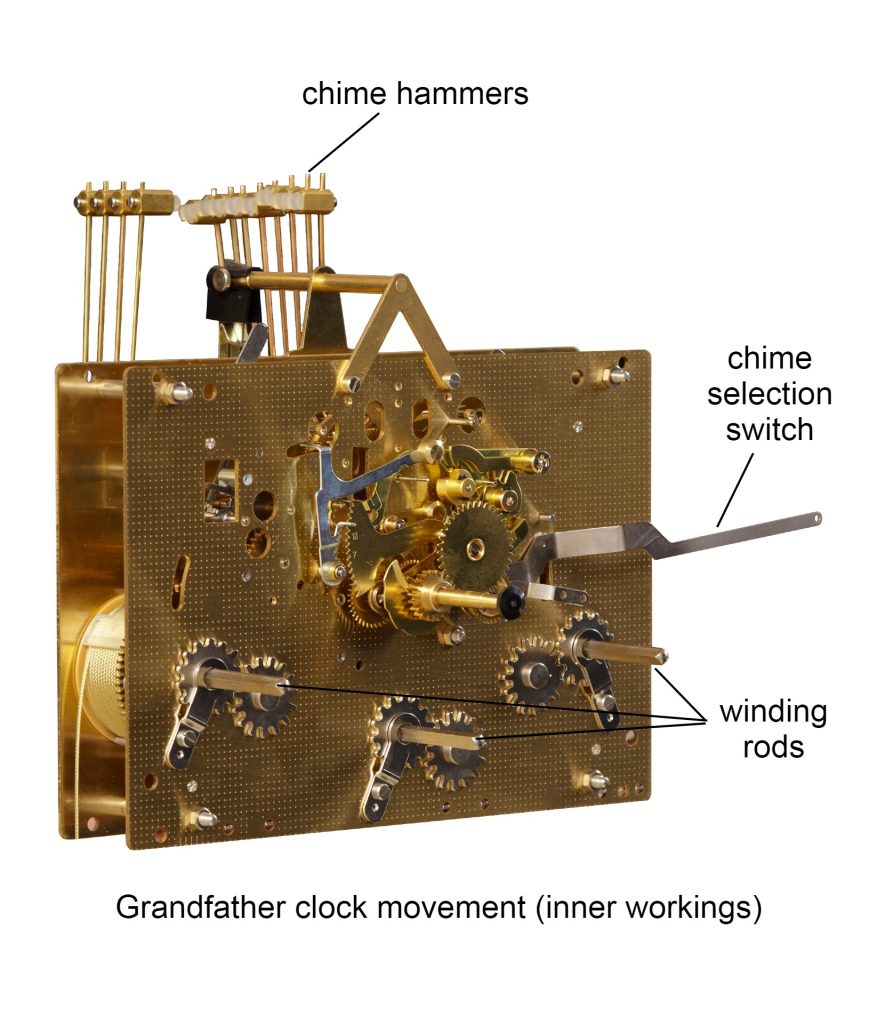
The movement is distinct from the clock cabinet. The clock cabinet is the wooden structure that houses the movement.
What Are the Different Types of Clock Movements?
Grandfather clocks generally come with two different types of movements: mechanical and battery operated.
Mechanical movements for grandfather clocks
A mechanical grandfather clock movement (pictured above) produces sound when hammers strike the chime rods at the back of the movement. The chime rods vibrate when struck, producing the beautiful sound known as the “chime”.
A mechanical movement is powered by weights which hang from chains or cables inside the clock case. A mechanical movement needs to be wound up periodically to keep it going.
The main advantage of a mechanical movement is its beautiful, authentic sound. Think about the difference in sound between a piano and electronic keyboard.
The disadvantages of a mechanical movement is that it needs to be wound up regularly to keep it running. It also needs period maintenance like oiling and cleaning. A mechanical movement is usually more expensive to purchase and maintain.
Battery operated movements
A battery clock movement is powered by batteries instead of weights. The main advantage is that you don’t need to windup battery movements. They are also cheaper to purchase and require very little maintenance.
The disadvantage is that there is a trade-off in sound quality with a battery movement. You just can’t beat the authentic ringing sound that is created when the hammers strike the chime rods with a mechanical movement.
What’s the Difference Between Chain Driven and Cable Driven Movements?
The weights that power the clock can be suspended from the grandfather clock movement using either chains or cables.
If suspended by cables, the movement is wound up by inserting the winding key into the winding holes on the clock face and turning counterclockwise (in most cases). If suspended by chains, the movement is wound up by pulling on the chains, which moves the chains over the top of a wheel and lifts the weights on the other side.
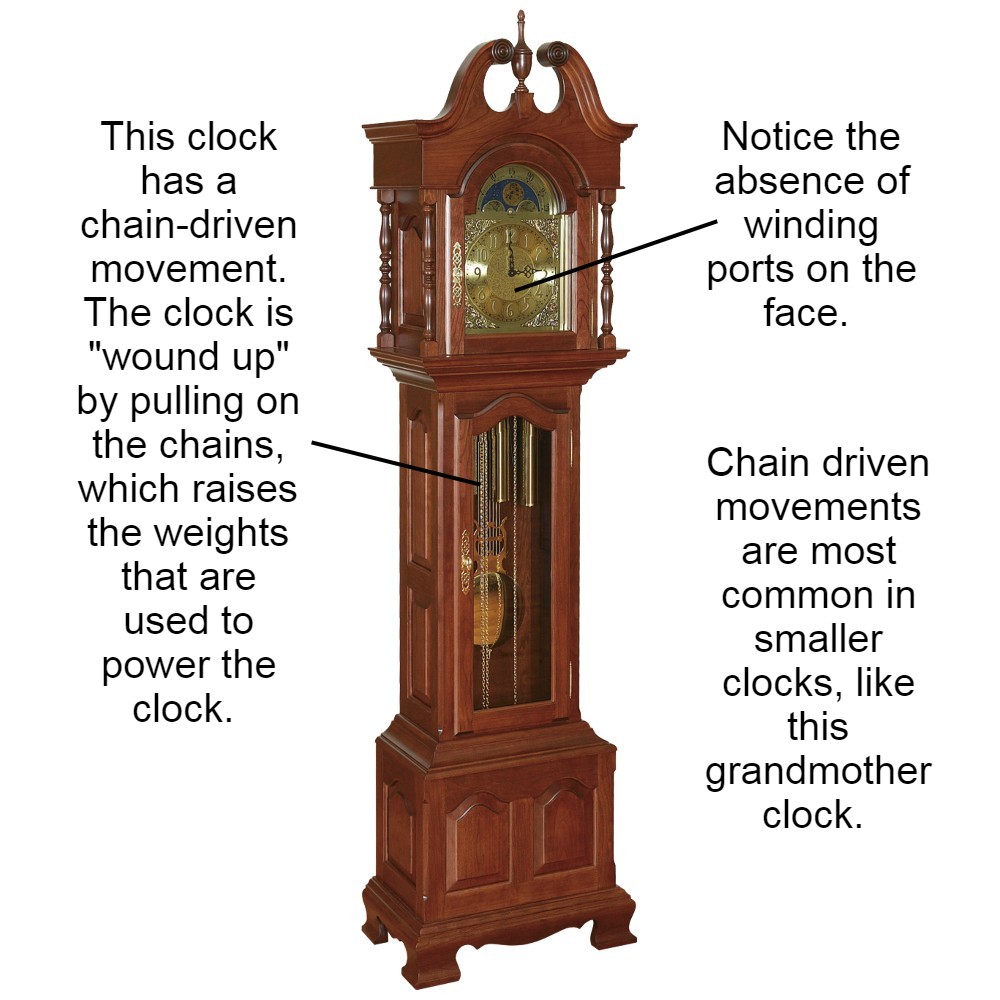
Chain driven movements are typically smaller in size and used in clocks like grandmother clocks.
“Winding up” a movement raises the weights before they reach the clock floor so that they can continue to fall and power the clock.
What Are the Chime Options for Grandfather Clocks?
A Westminster only chime only plays the classic Westminster tune. It has fewer chime rods because it needs to produce fewer notes.
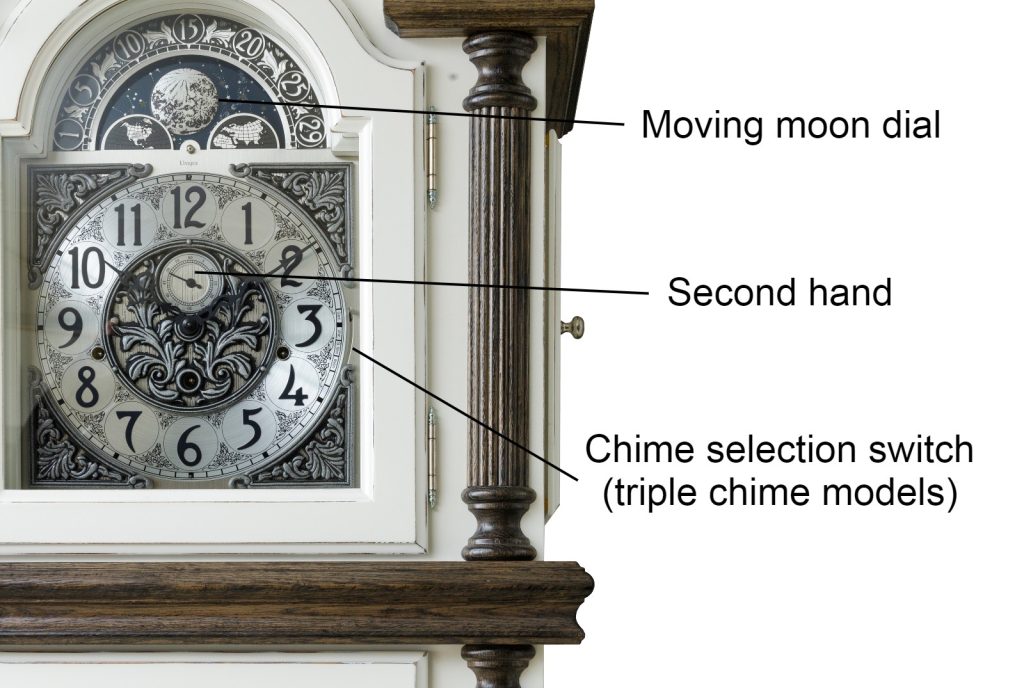
A triple chime movement can play 3 chime melodies including Westminster, St. Michaels, and Whittington. One of the 3 chimes can be selected for continuous play using the chime selection switch. The switch can also place the clock in silent mode. Below are demonstrations of the 3 chimes available in triple chimes.
Westminster
St. Michael’s
Whittington
Triple Chime tubular
This movement is considered the king of grandfather clock movements. Instead of hammers striking the chime rods, the hammers strike long tubes that hang down the back of the clock. This creates a beautiful ringing sound similar to a church bell.
Below is a video of the tubes being installed in the back of a tubular chime grandfather clock.
What is the auto-night shutoff feature?
The auto-night shutoff is a feature that automatically keeps the clock form chiming during the night time hours. The chimes are usually silenced from around 9 or 10 PM to 6 or 7 AM. Not all mechanical (windup) clocks come with this feature, so be sure to check before purchasing if that is important to you.
What’s the Difference Between a Grandfather Clock, A Grandmother Clock, and a Grandson Clock
Grandfather clocks are usually larger than grandmother clocks. A grandmother clock is a smaller version of a grandfather clock and is often slimmer around the mid-section.
A grandson clock is a miniature version of a grandfather clock. The weights on a grandson clock are non-functional, as there would not be enough room for the weights to fall. Instead the movement is powered by spring power (windup) or batteries.

Customizing Your Grandfather Clock
Custom grandfather clocks come with different levels of available customization. For some, customization means adding a custom name plate or engraving. For others, customization means building a clock completely from scratch based on a photo or drawing.
Up to this point, we have been writing in a more general sense about grandfather clocks, now we will focus more specifically on Amish grandfather clocks built by Old Time Chimes.
Here are the most common customizations and the options that are available for each type of customization.
Wood Options for Custom Grandfather Clocks
The most common type of customization is the wood and stain.
Like all types of fine furniture, many different species of wood can be used to create a timepiece that is prized for its longevity and beauty. These wood types include but are not limited to the following list of wood types.
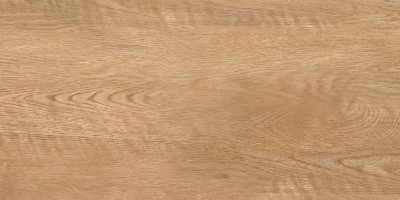
Red Oak
This hardwood has a coarser grain than many other hardwoods. Natural colors vary from light tan to reddish hues. Grains are mostly straight.
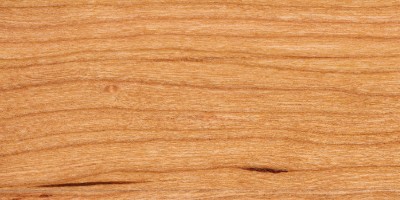
Cherry
A prized hardwood for furniture, this hardwood is smooth grained and has a naturally reddish brown color.
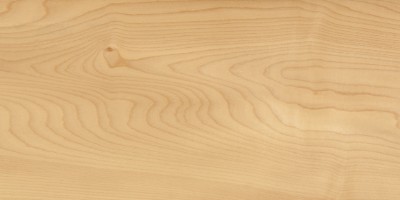
Maple
The grain is smooth, and generally straight or wavy. The natural color is nearly white or cream with hints of red and gold. Maple wood can be used to achieve a very smooth and glossy finish.
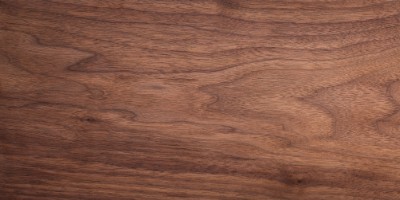
Walnut
This wood is full of character. It has a fine yet open grain and comes in bold dark colors with unique patterns. It is one of the darkest of the hardwoods in color.

Ash
A hardwood with a lighter heartwood color, wider spaced growth rings, and a texture similar to oak.
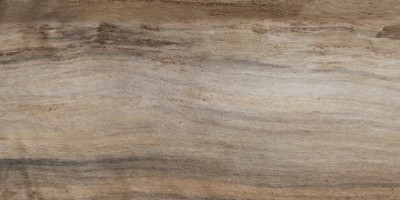
Hickory
This wood has a notable color difference between the sapwood and heartwood, making it a unique and attractive option for fine furniture. It is also a heavier wood in weight.

Elm
A beautiful wood that is often found in light to medium reddish brown colors. It is often smooth and straight grained with a wavy pattern.
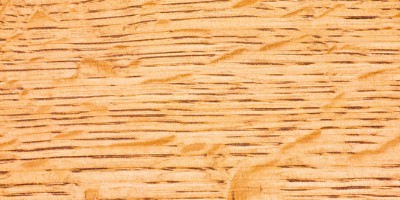
Quarter Sawn White Oak
This wood has a unique appearance due to the way that it is cut. It is generally light tan in color and can be found in many pieces of antique furniture.
Choosing Your Custom Clock Stain or Finish
When it comes to stain colors, the options are nearly endless.
Many Amish fine furniture builders use the Ohio Certified Stain (OCS) colors as the standard when it comes to choosing a stain color. OCS stain colors were developed as a way to standardize stain colors for the furniture industry. OCS stains make it easier to match stain colors when ordering different pieces of furniture from different builders. Below are a some of the stain options we offer as standard options.
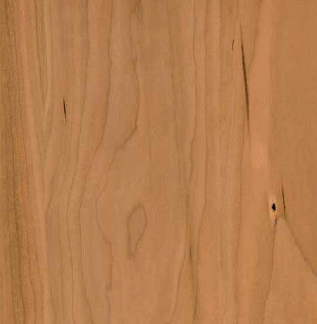



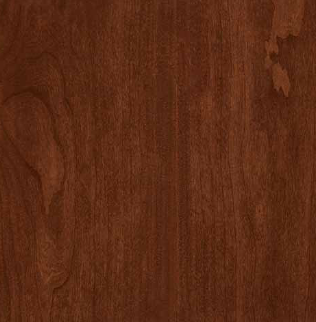
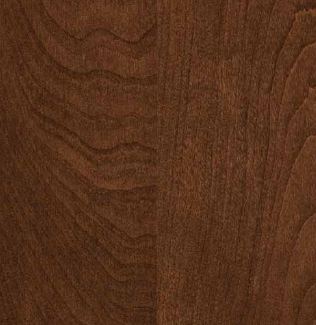
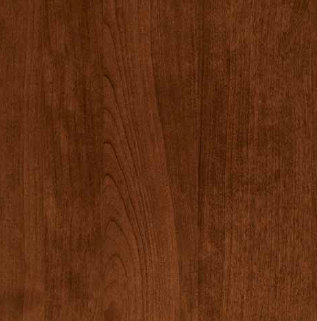
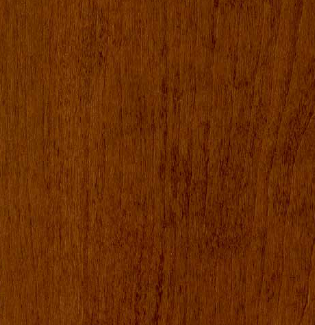
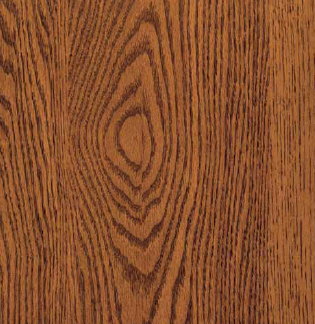


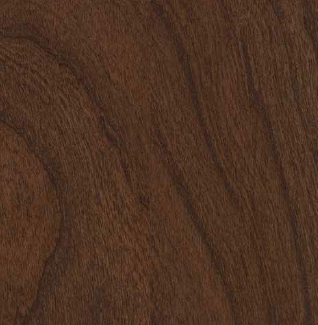

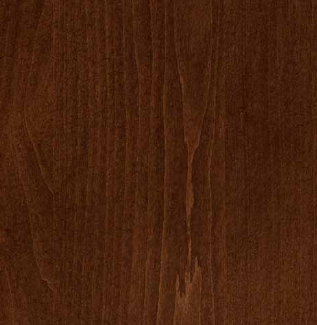
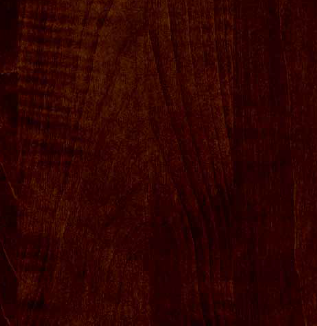

Visit this page to explore the OCS stain colors.
You can also contact us to order a free printed stain color catalog.
Besides OCS stains, coloring matching technology has made it relatively easy to take any stain or paint sample and match it. If you have a sample of a color that you like, whether paint or stain, you can send it to us and we’ll match it.
Antiquated finish
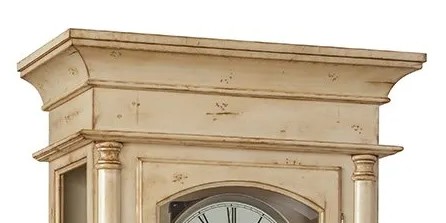
Another finish option is known as “antiquated distressing” and includes nicks and imperfections in the wood along with a coating of glazing to create a piece of furniture with an antique appearance.
Burnt edges

Another finishing technique is to burn the edges of the wood before the clock is stained. This darkens the wood color and creates more color variation and interest in the finished product.
Two-tone Finish
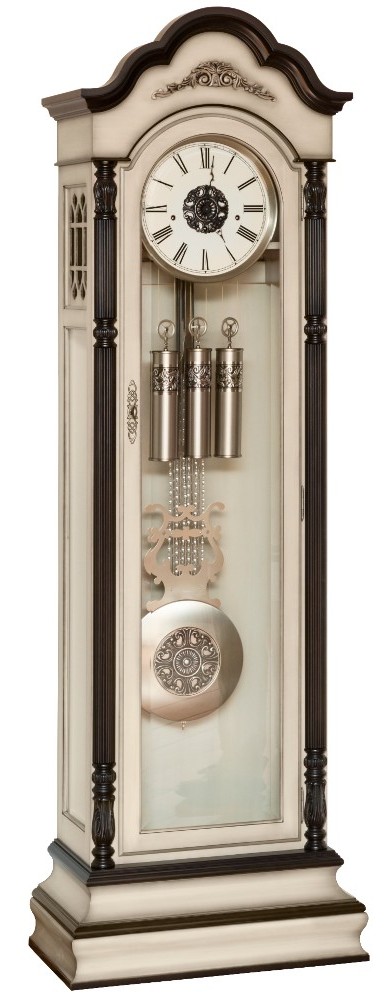
Various parts of the clock and moldings can be finished in different colors to create beautiful color variations.
Metal Components for A Grandfather Clock
Most of our clocks can be customized with the color of the metal components in either silver or brass. This includes the pendulum, weights, and the clock face.
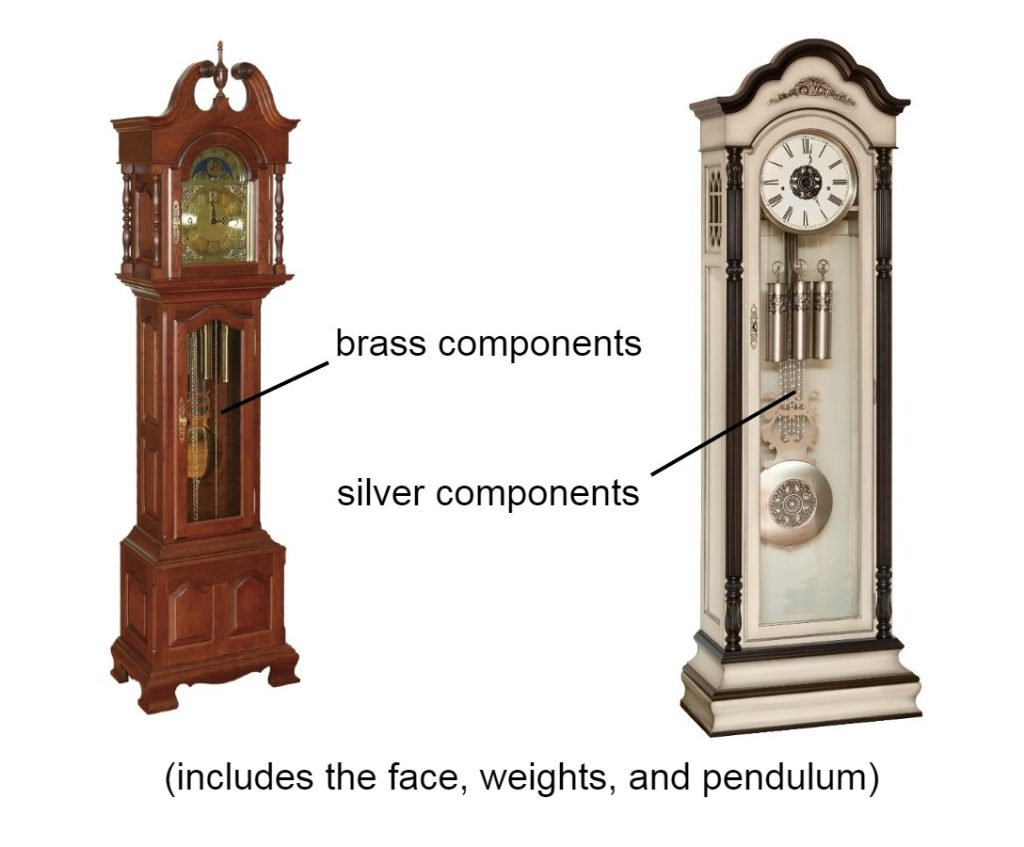
Clock Face Styles
There are often several different types of faces available for each clock. Most faces can be customized with either Roman numeral or Arabic numerals.
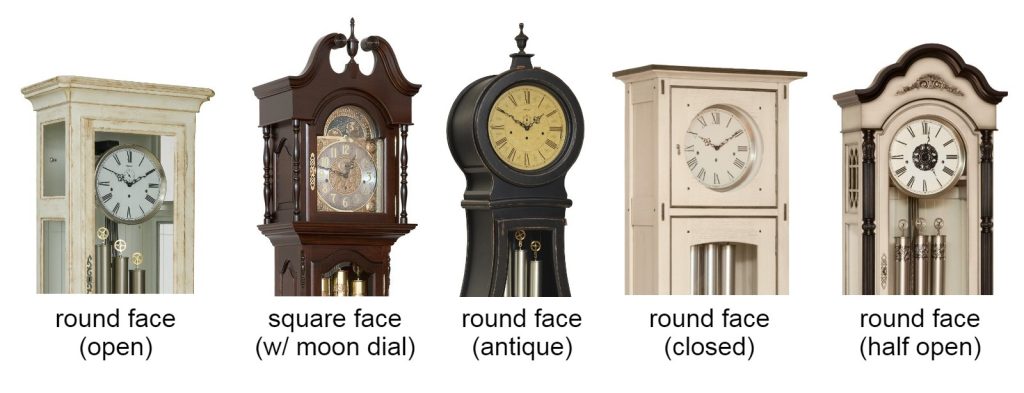
Face designs include round and square designs. The square design usually has a half-moon shape at the top which creates space for the moon dial.
What is a Moon Dial?
Many of our grandfather clocks come standard with a moving moon dial. The moon dial tracks the moon phases throughout the course of the month.
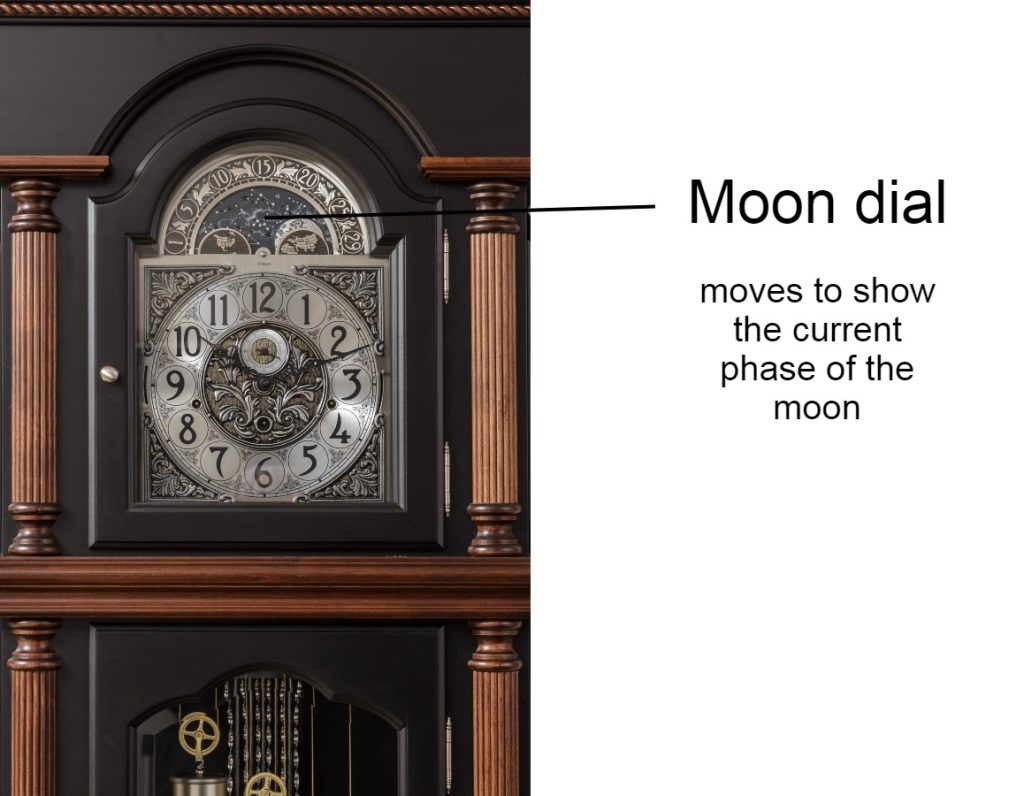
Weight and Pendulum Designs
Weights and the pendulum bob can be plain or may include intricate designs of scroll work and other patterns. The pendulum has several different design options, including the lyre pendulum, wood stick pendulum, and metal rod pendulum.
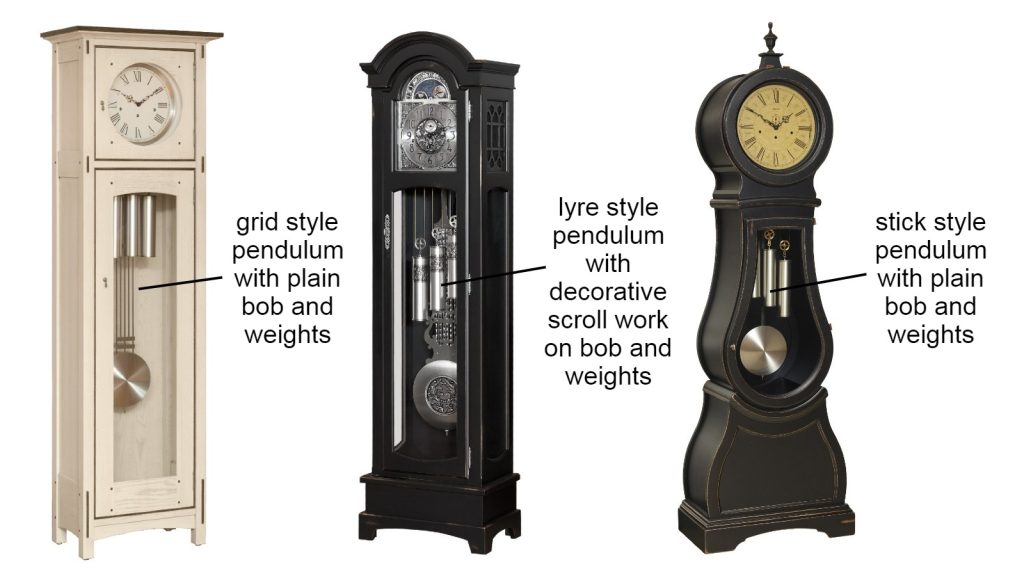
Clock Cabinet Designs
Clock designs fall in the categories of traditional, contemporary, and transitional. The design you choose depends on personal preference and the existing décor in your home.
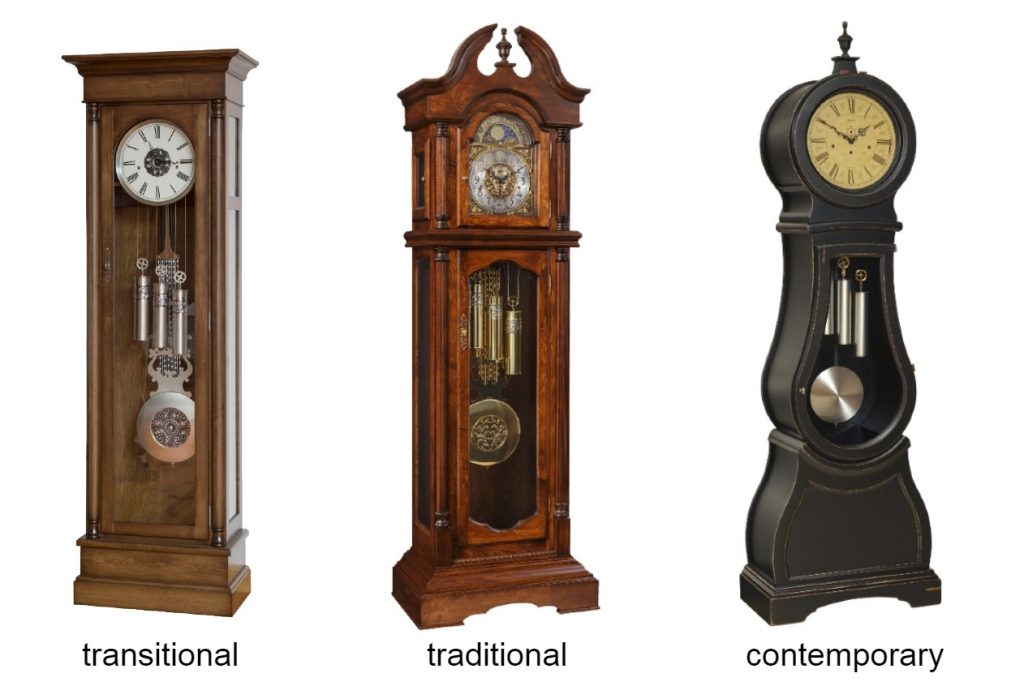
Clock Crown Styles
The most noticeable part of the grandfather clock cabinet is the crown. There are several common crown designs, including the split pediment, the bonnet, flat top, and the round top.
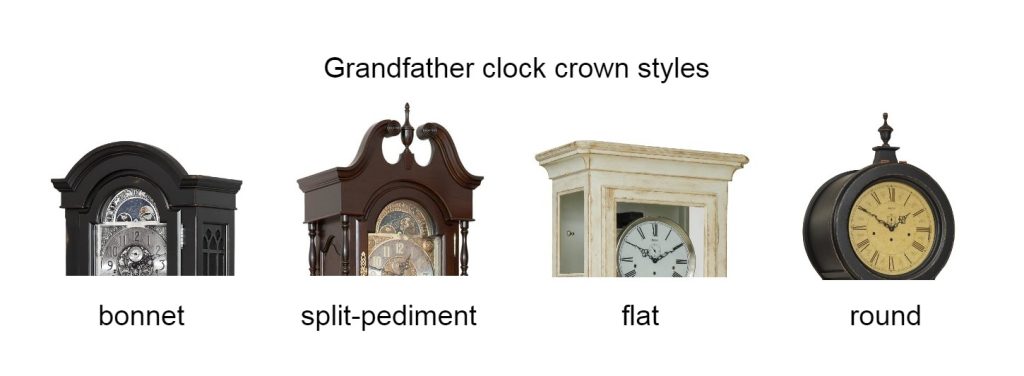
Clock Bases
The clock base is also an important part of the design with many different variations available.

Cabinet Customization Options
Clock cabinets can be customized with almost unlimited variations of moldings and carvings to create a unique appearance.

Carving options including portraits and CNC or hand carvings based on a photo or painting.
Besides wood carvings, another customization option is glass engravings, which can range anywhere from simple to complex.
Beveled glass
The glass can be beveled which adds elegance to any grandfather clock.

Glass in sides
Many grandfather clocks come with glass in the sides, which gives the clock more of an open feel and allows the viewer to see the hammers in action while striking the chimes rods. In many cases the upper glass panel is removable to allow easy access to the movement.
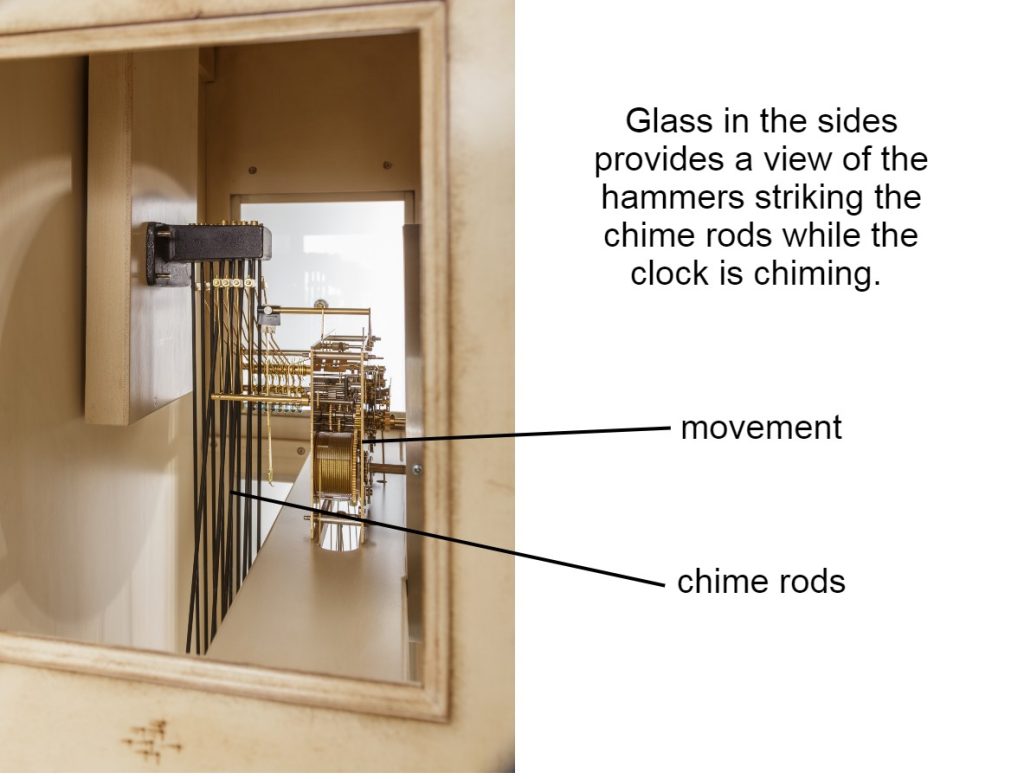
Interior Lighting for a Grandfather Clock
Interior lighting can be utilized to highlight different parts of the clock. It is typically battery powered or powered by a cord plugged into an outlet. Battery powered lighting adds the convenience of not needing a power cord.

How Much Does a Grandfather Clock Cost?
Custom grandfather clock prices begin around $4,500 but more typically fall in the $6,000 to $8,000 range depending on the model and options chosen.
You can browse through our clock models on our website at the button below to customize a grandfather clock and see the price.
How Long Does a Grandfather Clock Last?
Purchasing a grandfather clock is most likely a once in a life-time event. It is purchased for more than telling time. A grandfather clock symbolizes enduring family traditions and relationships. Therefore it is expected that a grandfather clock will last for a long time, long enough to be passed down to following generations.
With proper care, a grandfather clock can be expected to last for generations. However, there is a difference between the grandfather clock cabinet, and the clock movement, which controls the time keeping and chiming part of the clock.
A grandfather clock cabinet that’s well built using quality materials should last for decades or even centuries with little to no maintenance. The movement, however, requires regular maintenance to keep it operational.
The movement has many moving parts, which means that it should be oiled to keep it in peak operating condition. A grandfather clock movement should be oiled by a clock specialist every 3-5 years. Failure to keep a clock movement oiled may result in early failure of the movement.
Never use oil that’s not designed for clock use to oil a clock movement.
Oiling a grandfather clock movement is a basic service that’s offered by most clock repair specialists. Prices to oil and clean a movement usually start at $150 and may be higher depending on the location and types of additional services that may be required.
A grandfather clock movement that’s regularly maintained and oiled can be expected to last 25-30 years. After this amount of time has passed, it can be expected that some of the moving parts will need to be replaced in order to keep the movement going.
Still Have Questions?
We’d love to help you get all your questions answered as you research and shop for a custom grandfather clock. If you have any more questions please contact us by clicking on the button below and we’ll do our best to help you.
